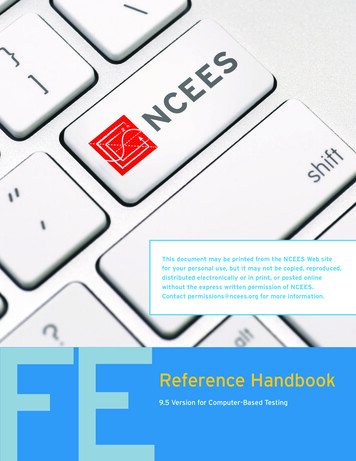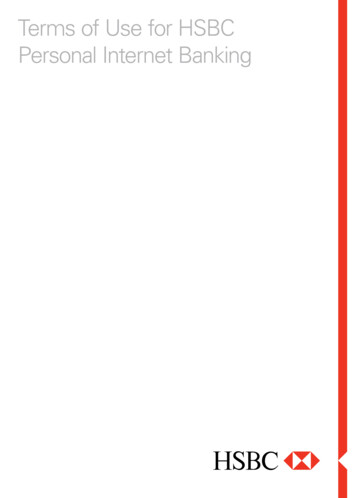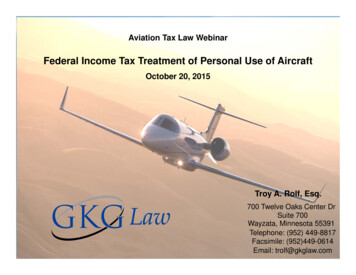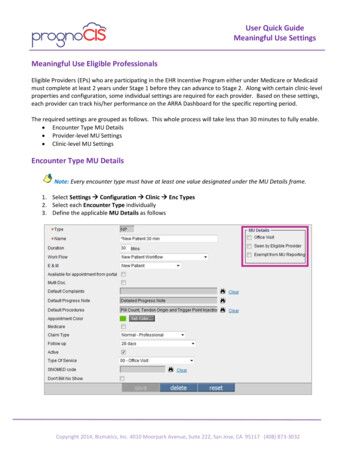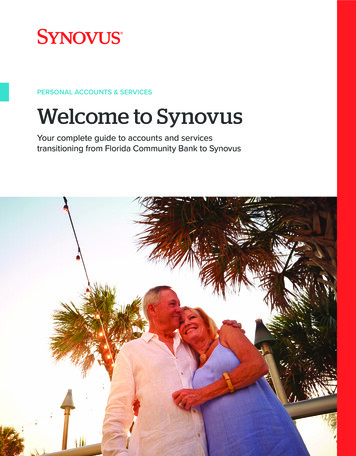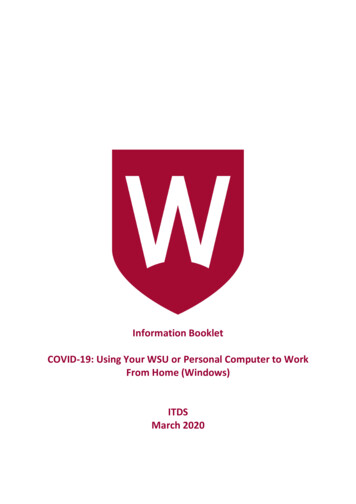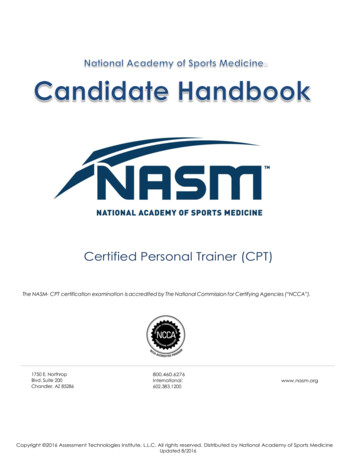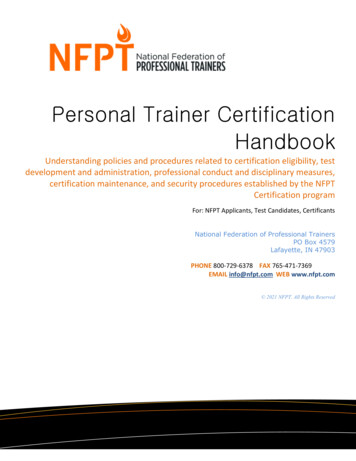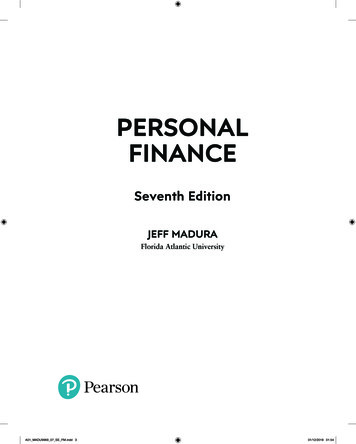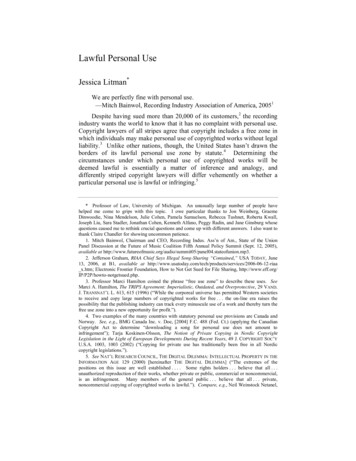
Transcription
Lawful Personal UseJessica Litman*We are perfectly fine with personal use.—Mitch Bainwol, Recording Industry Association of America, 20051Despite having sued more than 20,000 of its customers,2 the recordingindustry wants the world to know that it has no complaint with personal use.Copyright lawyers of all stripes agree that copyright includes a free zone inwhich individuals may make personal use of copyrighted works without legalliability.3 Unlike other nations, though, the United States hasn’t drawn theborders of its lawful personal use zone by statute.4 Determining thecircumstances under which personal use of copyrighted works will bedeemed lawful is essentially a matter of inference and analogy, anddifferently striped copyright lawyers will differ vehemently on whether aparticular personal use is lawful or infringing.5* Professor of Law, University of Michigan. An unusually large number of people havehelped me come to grips with this topic. I owe particular thanks to Jon Weinberg, GraemeDinwoodie, Nina Mendelson, Julie Cohen, Pamela Samuelson, Rebecca Tushnet, Roberta Kwall,Joseph Liu, Sara Stadler, Jonathan Cohen, Kenneth Alfano, Peggy Radin, and Jane Ginsburg whosequestions caused me to rethink crucial questions and come up with different answers. I also want tothank Claire Chandler for showing uncommon patience.1. Mitch Bainwol, Chairman and CEO, Recording Indus. Ass’n of Am., State of the UnionPanel Discussion at the Future of Music Coalition Fifth Annual Policy Summit (Sept. 12, 2005),available at 4.stateofunion.mp3.2. Jefferson Graham, RIAA Chief Says Illegal Song-Sharing “Contained,” USA TODAY, June13, 2006, at B1, available at 6-06-12-riaax.htm; Electronic Frontier Foundation, How to Not Get Sued for File Sharing, http://www.eff.org/IP/P2P/howto-notgetsued.php.3. Professor Marci Hamilton coined the phrase “free use zone” to describe these uses. SeeMarci A. Hamilton, The TRIPS Agreement: Imperialistic, Outdated, and Overprotective, 29 VAND.J. TRANSNAT’L L. 613, 615 (1996) (“While the corporeal universe has permitted Western societiesto receive and copy large numbers of copyrighted works for free . . . the on-line era raises thepossibility that the publishing industry can track every minuscule use of a work and thereby turn thefree use zone into a new opportunity for profit.”).4. Two examples of the many countries with statutory personal use provisions are Canada andNorway. See, e.g., BMG Canada Inc. v. Doe, [2004] F.C. 488 (Fed. Ct.) (applying the CanadianCopyright Act to determine “downloading a song for personal use does not amount toinfringement”); Tarja Koskinen-Olsson, The Notion of Private Copying in Nordic CopyrightLegislation in the Light of European Developments During Recent Years, 49 J. COPYRIGHT SOC’YU.S.A. 1003, 1003 (2002) (“Copying for private use has traditionally been free in all Nordiccopyright legislations.”).5. See NAT’L RESEARCH COUNCIL, THE DIGITAL DILEMMA: INTELLECTUAL PROPERTY IN THEINFORMATION AGE 129 (2000) [hereinafter THE DIGITAL DILEMMA] (“The extremes of thepositions on this issue are well established . . . . Some rights holders . . . believe that all . . .unauthorized reproduction of their works, whether private or public, commercial or noncommercial,is an infringement. Many members of the general public . . . believe that all . . . private,noncommercial copying of copyrighted works is lawful.”). Compare, e.g., Neil Weinstock Netanel,
1872Texas Law Review[Vol. 85:1871The dispute is not simply a question of where one lives on the copyrightfood chain. The contours of lawful personal use are fuzzy as well ascontested.6 Every time a study of copyright law queries the scope of lawfulpersonal use, it concludes that the answer to the question whether any particular personal use is lawful is indeterminate.7 Wherever the fuzzy bordersof lawful personal use lie, however, most would agree that the lawful personal use zone is shrinking.Congress has significantly expanded the breadth of copyright protectionin the past few decades; some of that expansion has come at the expense ofpersonal use.8 The proliferation of digital technology has made personal useboth easier to track, trace, and charge for,9 and a more formidable threat toconventional commercial exploitation of copyrights.10 Copyright ownershave therefore launched a variety of initiatives to replace unmetered and unmonitored personal uses with licensed ones. They have demanded therestraint of unauthorized personal use as a necessary step in encouraging thenew commercial services to flourish.11 Meanwhile, individuals’ claims tomake personal copies and pass them on to friends and family seem moreCopyright and a Democratic Civil Society, 106 YALE L.J. 283, 300 (1996) (“[C]ourts havegenerally declined to find personal copying as infringing.”), with Jane C. Ginsburg, From HavingCopies to Experiencing Works: The Development of an Access Right in U.S. Copyright Law, 50 J.COPYRIGHT SOC’Y U.S.A. 113, 120 (2003) (“U.S. and international copyright law have increasinglyrecognized that the author’s right to authorize, or at least to be compensated for, the making ofcopies, extends . . . to end-users who make individual copies for private consumption.”).6. See Jessica Litman, War Stories, 20 CARDOZO ARTS & ENT. L.J. 337, 338, 338–50 (2002)[hereinafter Litman, War Stories] (“[T]he question whether individuals are liable for copyrightinfringement when they make unauthorized uses of copyrighted works has no clear answer.”).7. See OFFICE OF TECH. ASSESSMENT, COPYRIGHT AND HOME COPYING: TECHNOLOGYCHALLENGES THE LAW 5, 5 14 (1989) (“The problem of private use arises because its legal statusis ambiguous.”); THE DIGITAL DILEMMA, supra note 5, at 135, 129 36 (“This report cannot resolvethe debate over private use copying.”); Alan Latman, Fair Use of Copyrighted Works, in 2 STUDIESON COPYRIGHT 781, 789–90 (Copyright Soc’y of the U.S. ed., 1963); Borge Varmer,Photoduplication of Copyrighted Material by Libraries, in 2 STUDIES ON COPYRIGHT, supra, at813, 817 (“It may be that copying for one’s own private use . . . is sanctioned by custom . . . .”).8. E.g., Digital Millennium Copyright Act, Pub. L. No. 105-304, 112 Stat. 2860 (1998)(codified as amended in scattered sections of 17 U.S.C. (2000)); No Electronic Theft (NET) Act,Pub. L. No. 105-147, § 2(a)–(b), 111 Stat. 2678, 2678 (1997) (codified at 17 U.S.C. §§ 101, 506);Computer Software Rental Amendments Act of 1990, Pub. L. No. 101-650, §§ 801–05, 104 Stat.5089, 5134–37 (codified at 17 U.S.C. § 109); Record Rental Amendment of 1984, Pub. L. No. 98450, § 2, 98 Stat. 1727, 1727 (codified at 17 U.S.C. § 109).9. See, e.g., Sonia K. Katyal, Privacy vs. Piracy, 9 INT’L J. COMM. L. & POL’Y (SPECIAL ISSUE)1, 7 (2004–2005) (“[P]rivate entities have successfully monitored transmissions in cyberspace tocontrol uses of their copyrighted materials.”); Jessica Litman, Reforming Information Law inCopyright’s Image, 22 U. DAYTON L. REV. 587, 606, 602–13 (1997) [hereinafter Litman,Reforming Information Law] (“[T]he Internet has made it simpler to prevent, detect and avengeunauthorized copying.”).10. See, e.g., Ginsburg, supra note 5, at 114, 113–14 (“[D]igital media and communicationsmade it even easier for consumers to create physical copies of any kind of work . . . .”).11. See, e.g., Am. Library Ass’n v. FCC, 406 F.3d 689, 691, 693–96 (D.C. Cir. 2005)(describing the entertainment industries’ “broadcast flag” campaign).
2007]Lawful Personal Use1873questionable when those copies are digital.12 Copyright owners haveinsisted, with some success, that digital devices must be equipped with copyprevention technology before being made available to consumers.13Increasingly, what consumers have viewed as a “right” to make fair uses ofcopyrighted works is painted as a historically and technologically contingentprivilege that may need to yield to copyright owners’ new licensingstrategies.14Fifty years ago, copyright law rarely concerned itself with uses thatwere not both commercial and public.15 Twenty years ago, when theSupreme Court’s decision in Sony Corp. of America v. Universal CityStudios, Inc.16 was still fresh, people believed they were free to use copyrighted works noncommercially, and the law for the most part backed up thatbelief.17 Today, however, the recording industry has sued more than 20,00012. See THE DIGITAL DILEMMA, supra note 5, at 129, 129–45 (“[T]he risk to rights holdersfrom unbridled private copying is especially acute when the information is in digital form and canbe copied without loss of quality and disseminated by digital networks.”); Netanel, supra note 5, at299, 299–301 (“With readily available consumer electronics and digital technology . . . individualconsumers are now able to make perfect copies of many cultural works at virtually no cost.”).13. See, e.g., Universal City Studios, Inc. v. Corley, 273 F.3d 429, 436, 436–44 (2d Cir. 2001)(“The movie studios were reluctant to release movies in digital form until they were confident theyhad in place adequate safeguards against piracy of their copyrighted movies.”); see also ElectronicFrontier Foundation, EFF: The Battle for Your Digital Media Devices, http://www.eff.org/IP/fairuse/ (“Major entertainment companies are locking up the audio and video content you own andtaking away your rights.”); Electronic Frontier Foundation, EFF: Endangered Gizmos!,http://www.eff.org/endangered/ (illustrating new technologies that are threatened because of theircopying ability).14. See, e.g., Jane C. Ginsburg, “The Exclusive Right to Their Writings”: Copyright andControl in the Digital Age, 54 ME. L. REV. 195, 201, 201–02 (2002) [hereinafter Ginsburg,Copyright and Control] (“[T]he . . . statutory and caselaw history until 1976 often elevated claimsfor enhanced availability . . . over copyright owner interest . . . . The 1976 Act, however,implements a vision of ‘exclusive rights’ to which control is integral.” (footnote omitted));Ginsburg, supra note 5, at 124 (“As we move to an access-based world of distribution ofcopyrighted works, a copyright system that neglected access controls would make copyrightillusory, and in the long run it would disserve consumers.”); see also U.S. PATENT ANDTRADEMARK OFFICE, NATIONAL INFORMATION INFRASTRUCTURE TASK FORCE WORKING GROUPON INTELLECTUAL PROPERTY: PUBLIC HEARING ON INTELLECTUAL PROPERTY ISSUES INVOLVEDIN THE NATIONAL INFORMATION INFRASTRUCTURE INITIATIVE 40–50 (1993) (remarks of Bruce A.Lehman, Chair, Working Group on Intellectual Property), available at http://www.umich.edu/ jdlitman/NOV18NII.TXT (suggesting that fair use may be unnecessary in an electronicenvironment).15. See Jessica Litman, The Exclusive Right to Read, 13 CARDOZO ARTS & ENT. L.J. 29, 35(1994) (“[T]he public believes that the copyright statute . . . does not reach private or noncommercial conduct. . . . Until recently . . . the public’s impression was not a bad approximation ofthe scope of copyright rights likely, in practice, to be enforced.”); Pamela Samuelson, Copyrightand Freedom of Expression in Historical Perspective, 10 J. INTELL. PROP. L. 319, 326 (2003) (“Forthe most part, the law of copyright has regulated public and commercial uses of copyrighted works,not private and noncommercial uses.”).16. 464 U.S. 417 (1984).17. See, e.g., Lewis Galoob Toys, Inc. v. Nintendo of Am., Inc., 964 F.2d 965, 970, 970–71(9th Cir. 1992) (“Game Genie users are engaged in a non-profit activity. Their use of the GameGenie to create derivative works therefore is presumptively fair.”); Joel L. McKuin, Home AudioTaping of Copyrighted Works and the Audio Home Recording Act of 1992: A Critical Analysis, 16
1874Texas Law Review[Vol. 85:1871individuals for making personal uses that can be characterized as“commercial” only by redefining commercial to mean “unlicensed.” Today,trading music with your friends is called “piracy” and collecting photocopiedarticles relevant to your job is stealing.18 Today, it’s a major concessionwhen the lawyer representing the recording industry acknowledges to theSupreme Court that it is lawful for twenty-two million iPod owners to usethem to listen to music they’ve copied from recordings they havepurchased.19Whether the shrinking of lawful personal use should disturb us dependson whether personal use has intrinsic value. If personal use was once lawfulsolely because of enforcement difficulties, the easy enforcement of copyrightprerogatives against individuals for unlicensed personal uses is yet anotherbenefit of technological progress. If the only factors discouraging us fromwelcoming the reduction in the scope of lawful personal use are concerns forthe collateral damage to our privacy arising from vigorous enforcement ofcopyright within the home, or the effects of reduced access on socialequality, we could address those fears directly by legislating new privacyrights or encouraging the adoption of innovative pricing models.If those suggestions fail to quell the queasiness you feel at the idea thatfewer and fewer personal uses remain lawful, then perhaps we’ve overlookedsome role that personal use plays in the copyright system. Missing such athing would certainly be understandable. We tend not to talk much aboutpersonal use when we’re considering copyright reform.20 Personal usershave historically found fervent advocates in copyright law discussions onlywhen they’re employing consumer electronic devices, and only from themanufacturers of those devices.21 Although copyright scholarship haswrestled with the lawfulness of personal uses since Universal Studios sued toHASTINGS COMM. & ENT. L.J. 311, 317, 317–21 (1994) (“The arguments for and against findinghome taping a fair use will not be repeated at length since not only have such arguments beenpresented many times before, but also [the Audio Home Recording Act of 1992] makes the debateirrelevant by deeming noncommercial taping a noninfringing activity.” (footnote omitted)).18. See Litman, War Stories, supra note 6, at 342–50 (tracing the evolution in language used todescribe contested uses of copyrighted works).19. Transcript of Oral Argument at 11–12, Metro-Goldwyn-Mayer Studios, Inc. v. Grokster,Ltd., 545 U.S. 913 (2005) (No. 04-480), available at nt transcripts/04-480.pdf.20. See Jessica Litman, Copyright Legislation and Technological Change, 68 OR. L. REV. 275,354, 348–54 (1989) [hereinafter Litman, Technological Change] (“[Members of Congress] have . . .demonstrated little eagerness for grappling with the general problems that private use poses.”).21. See JESSICA LITMAN, DIGITAL COPYRIGHT 59–61, 122–45 (2006) [hereinafter LITMAN,DIGITAL COPYRIGHT] (reviewing the legislative history of the Audio Home Recording Act and theDigital Millennium Copyright Act); Pamela Samuelson, The Generativity of Sony v. Universal: TheIntellectual Property Legacy of Justice Stevens, 74 FORDHAM L. REV. 1831, 1841 (2006) (“[Sony]also argued that time-shift copying was a fair use and that Congress had intended to exempt privateuse home taping from radio or TV from claims of copyright infringement.”).
2007]Lawful Personal Use1875enjoin the Sony Betamax,22 we’ve had some difficulty coming up with usefulformulations. As copyright law has expanded to encompass more and moreterritory, our vocabulary to describe the remainder has seemed to shrink aswell.Particular scholars have sought to infuse the debate with a morenuanced analysis. Professors Julie Cohen,23 Yochai Benkler,24 RebeccaTushnet,25 and Neil Netanel,26 among others, have attempted to derive legalprinciples that protect the interests of those who experience, rather thancreate, copyrighted works from the First Amendment.27 Professor L. RayPatterson, among others, found users’ rights in the copyright and patentclause of the Constitution.28 Professors Joseph Liu and Glynn Lunney,22. See, e.g., Wendy J. Gordon, Fair Use as Market Failure: A Structural and EconomicAnalysis of the Betamax Case and Its Predecessors, 82 COLUM. L. REV. 1600, 1652–57 (1982)(analyzing home videotaping as a case of market failure); L. Ray Patterson, Free Speech, Copyright,and Fair Use, 40 VAND. L. REV. 1, 40 (1987) (“A fair use doctrine intended to permit competitorsto make reasonable use of a work is quite different from a fair use doctrine that makes a consumer’suse of the work for ordinary purposes suspect.”).23. See Julie E. Cohen, Copyright and the Jurisprudence of Self-help, 13 BERKELEY TECH. L.J.1089 (1998) (discussing users’ rights to hack DRM); Julie E. Cohen, A Right to Read Anonymously:A Closer Look at “Copyright Management” in Cyberspace, 28 CONN. L. REV. 981 (1996)[hereinafter Cohen, A Right to Read] (discussing right to read anonymously).24. See Yochai Benkler, Free as the Air to Common Use: First Amendment Constraints onEnclosure of the Public Domain, 74 N.Y.U. L. REV. 354, 393 (1999) (suggesting a FirstAmendment basis for a user’s right of access to the public domain); Yochai Benkler, FromConsumers to Users: Shifting the Deeper Structures of Regulation Toward Sustainable Commonsand User Access, 52 FED. COMM. L.J. 561 (2000) (arguing that First Amendment interests requireregulators to ensure broad public access to the tools for generating and disseminating expression);Yochai Benkler, Through the Looking Glass: Alice and the Constitutional Foundations of thePublic Domain, LAW & CONTEMP. PROBS., Winter–Spring 2003, at 173 (2003) (articulating FirstAmendment constraints on Congress’s power to restrict individual rights to read and speak).25. See Rebecca Tushnet, Copy This Essay: How Fair Use Doctrine Harms Free Speech andHow Copying Serves It, 114 YALE L.J. 535, 587 (2004) (“Courts should recognize that variouskinds of copying . . . promote free speech. . . . The point is not to denigrate fair use, but torecognize that many kinds of uses of copyrighted material may be justified . . . .”).26. See generally Netanel, supra note 5 (analyzing conflicts between the First Amendment andcopyright, and suggesting resolutions).27. See, e.g., C. Edwin Baker, First Amendment Limits on Copyright, 55 VAND. L. REV. 891,904 (2002) (“The expressive liberty protected by the First Amendment encompasses copying as away of receiving or preserving personal access . . . and distributing copies as a means ofcommunicating to others what the distributor wants to communicate.”); Malla Pollack, TheDemocratic Public Domain: Reconnecting the First Amendment and the Original Progress Clause(A.K.A. Copyright and Patent Clause), 45 JURIMETRICS J. 23, 27 (2004) (“The Clause limitsCongress, demonstrating that the base right is in the public, not in the government, the inventors,nor the writers.”); Jed Rubenfeld, The Freedom of Imagination: Copyright’s Constitutionality, 112YALE L.J. 1, 38 (2002) (“Because it protects the freedom of imagination, the First Amendmentdirectly protects not only speakers, but readers, viewers, and listeners as well.”); Diane LeenheerZimmerman, Is There a Right to Have Something to Say? One View of the Public Domain, 73FORDHAM L. REV. 297, 326 (2004) (“Speech requires content to be meaningful. This includessome ability to acquire such content and certainly the privilege of using it.”).28. See L. Ray Patterson, Eldred v. Reno: An Example of the Law of Unintended Consequences,8 J. INTELL. PROP. L. 223, 228 (2001) (“[T]he governing principle of both the First Amendment andthe Copyright Clause is the right of public access to materials that enable the people to learn, for
1876Texas Law Review[Vol. 85:1871among others, have suggested that we find a theoretical basis for protectingconsumers within the four corners of copyright law itself.29 Both Cohen andLiu have criticized as reductionist the common depictions of users in thecopyright literature and have sought to refine our understanding of how theinterests of users and consumers have been underappreciated in current copyright law and copyright legal scholarship.30In the summer of 2005, the unanimous Supreme Court decision in MGMv. Grokster 31 caused the unsettled issue of personal use to assume increasedimportance.32 The decision drew a line between the distributors of technology that makes infringement easier who would be liable for their customers’infringing use and the distributors of like technology who would not.33 Thedifference, the Court held, lay in whether the distributors had promoted infringing or noninfringing use.34 To assess likely contributory liability weneed to know what personal uses are infringing. That question is morepressing because the recording and motion picture industries, which initiallypainted their suits against individuals as a last resort given the lower courtrulings in Grokster’s favor,35 have apparently found the practice of suinghundreds of peer-to-peer file sharers each month too delicious a habit topolitical purposes in some instances, and for personal education in others.”); Patterson, supra note22, at 61 (“The copyright owner, by reason of the Copyright Act and the copyright clause, has notonly no right to interfere, but a duty not to interfere with the consumer’s use of a publiclydisseminated work.”); see also Deborah Tussey, From Fan Sites to Filesharing: Personal Use inCyberspace, 35 GA. L. REV. 1129, 1134 (2001) (arguing that the policies underlying the copyrightand patent clause support the enactment of a personal use privilege).29. See Joseph P. Liu, Copyright Law’s Theory of the Consumer, 44 B.C. L. REV. 397, 398(2003) (“After all, the overall purpose of the Copyright Act is not to reward authors for authors’sake, but to reward authors to benefit consumers and society more generally.”); Glynn S. Lunney,Jr., Fair Use and Market Failure: Sony Revisited, 82 B.U. L. REV. 975, 977 (2002) (“With thedevelopment and dissemination of digital technology, the importance of private copying and itslegal status, whether fair or unfair under copyright law, has only increased.”).30. See Julie E. Cohen, The Place of the User in Copyright Law, 74 FORDHAM L. REV. 347,347–48 (2005) (“Copyright doctrine, however, is characterized by the absence of the user. . . .[This] absence produces a domino effect that ripples through the structure of copyright law, shapingboth its unquestioned rules and its thorniest dilemmas.”); Liu, supra note 29, at 398 (“[C]onsumerinterests are quite a bit more complex than we ordinarily think.”).31. Metro-Goldwyn-Mayer Studios, Inc. v. Grokster, Ltd., 545 U.S. 913 (2005).32. See Jonathan Band, So What Does Inducement Mean?, COMPUTER & INTERNET L., Nov.2005, at 1, 2 (“[T]his redefinition of contributory infringement . . . appears to run contrary to theSupreme Court’s discussion of contributory infringement in Sony.”).33. Grokster, 545 U.S. at 934–40.34. Id. at 937–39.35. See Pornography, Technology and Process: Problems and Solutions on Peer-to-PeerNetworks: Hearing Before the S. Comm. on the Judiciary, 108th Cong. (2003) (statement of CarySherman, President and General Counsel, Recording Industry Association of America), available athttp://judiciary.senate.gov/hearing.cfm?id 902 (“[F]or copyright owners, the John Doe procedure isa lose-lose: they no longer have access to an expeditious procedure for identifying alleged infringersand they are faced with significantly greater administrative and monetary burdens associated withenforcing their rights under the law.”).
2007]Lawful Personal Use1877break.36 The suits generate a few thousand dollars each and may have somedeterrent value.37 The economics of defending them make it unlikely thatindividual defendants will choose to litigate.38 We therefore face the prospect that thousands of consumers will pay stiff peer-to-peer taxes to therecording and motion picture industry each year without a meaningful chanceto establish whether they are doing something illegal.39 Nor should we feelconfident that the assault on personal use will stop at peer-to-peer filesharing. Flush from its victory over Grokster, the recording industrychanged its tune and explained that the copyright piracy threat posed by peerto-peer file sharing was insignificant compared with the threat posed by unauthorized CD burning, and that the industry was rolling out copy-protectedCDs to meet the threat.40 Meanwhile, both the motion picture industry andthe recording industry seek laws requiring consumer electronics companiesto incorporate copy prevention technology into digital televisions andradios.41 Thus, the effort to capture control over personal uses is movingfurther and further into consumers’ homes.4236. See, e.g., Press Release, Recording Indus. Ass’n of Am., RIAA Launches New InitiativesTargeting Campus Music Theft (Feb. 28, 2007), available at http://www.riaa.com/news/newsletter/022807.asp (“The Recording Industry Association of America (RIAA), on behalf of the majorrecord companies, today sent 400 pre-litigation settlement letters to 13 different universities. Eachletter informs the school of a forthcoming copyright infringement lawsuit against one of its studentsor personnel.”).37. See, e.g., Justin Hughes, On the Logic of Suing One’s Customers and the Dilemma ofInfringement-Based Business Models, 22 CARDOZO ARTS & ENT. L.J. 725, 744, 747–50 (2005)(suggesting that the “John Doe” suits deter some file sharing and may, in addition, become a profitcenter for the recording industry).38. See Jessica Litman, The Sony Paradox, 55 CASE W. RES. L. REV. 917, 958 (2005)[hereinafter Litman, Sony Paradox] (“[O]nly one of the 8000 consumers sued so far for peer-topeer file sharing by the recording industry has found the arguments in favor of personal copyingsufficiently compelling to be worth the risk of taking the law suit to trial.”).39. See Brief of Amici Curiae Law Professors in Support of Respondents at 3, Grokster, 545U.S. 913 (No. 04-480) (“[T]he right of private copying, which has existed (as a matter of legalrealism) for years, may well be lost not through a fair and vigorously contested adversary process,but through silence.”).40. See Mitch Bainwol, CEO, Recording Indus. Ass’n of Am., Address at the Nat’l Ass’n ofRecording Merchandisers Insights and Sounds Convention 2005, Building a Brighter Future:Making and Selling Great Music, at 58 (Aug. 12, 2005), http://www.narm.com/2005Convention/Bainwol.pdf (“Burning and Ripping Are Becoming A Greater Threat Than P2P”). The copyprotection software has not been entirely benign. In 2005, Sony BMG released a number ofrecordings on CDs that incorporated copy-protection technology. The CDs played normally in aconventional CD player, but, when inserted into a CD-ROM drive of a computer running theWindows operating system, the CDs automatically and secretly installed software on the user’scomputer. Press Release, FTC, Sony BMG Settles FTC Charges (Jan. 30, 2007), available athttp://www.ftc.gov/opa/2007/01/sony.htm. The Federal Trade Commission charged Sony BMGwith violating federal law, claiming that the software “Posed Security Risks, Limited CD Use, andMonitored Users’ Listening Habits on their Computers, Without Consumer Consent.” Id. Sonysettled the charges in January of 2007. Id.41. See Am. Library Ass’n v. FCC, 406 F.3d 689, 691 (D.C. Cir. 2005) (“[T]he Commissionadopted ‘broadcast flag’ regulations, requiring that digital television receivers . . . includetechnology allowing them to recognize the broadcast flag.”); Broadcast and Audio Flag: HearingBefore the S. Comm. on Commerce, Science, and Transportation, 109th Cong. 47 (2006), available
1878Texas Law Review[Vol. 85:1871This Article seeks to refocus the discussion of users’ and consumers’rights under copyright, by placing people who make personal use ofcopyright works at the center of the copyright system. The view of copyrightthat such a reconfiguration permits yields some useful insights. It allows usto look at nineteenth and twentieth century copyright cases in a new light.Rather than viewing those opinions as decisions by common law judges construing statutes stingily,43 we can appreciate them as interpretations informedby a view of copyright in which readers and listeners were as important asauthors and publishers.I propose in this Article to look at the place of readers, listeners,viewers, and the general public in copyright through the lens of personal use.After Grokster, the topic of personal use is timely, indeed critically so. Limiting myself to personal use, moreover, allows me to evade, for now, many ofthe interesting questions that arise when readers, listeners, users, and experiencers morph into publishers and distributors.44 Finally, personal use is arealm where even the most rapacious copyright owners have always agreedthat some uses are lawful even though they are neither exempted orat http://commerce.senate.gov/pdf/bainwol-012406.pdf (hearing on proposals for legislationdirecting the FCC to implement the broadcast flag); Anne Broache, Senators Aim to Restrict Net,Satellite Radio Recording, CNET NEWS.COM, Jan. 16, 2007, http://news.com.com/2102-1028 36149915.html (“[Proposed legislation] says that all audio services . . . would be obligated toimplement ‘reasonably available and economically reasonable’ copy-protection technology aimed atpreventing ‘music theft’ and restricting automatic recording.”); Electronic Frontier Foundation,EFF: Broadcast Flag, http://www.eff.org/IP/broadcastflag/ (“[I]f the broadcast flag mandate ispassed, Hollywood and federal bureaucrats will get a veto over innovative devices and legitimateuses of recorded programming. The mandate forces all future digital television (DTV) tuners toinclude ‘content protection’ (aka DRM) technologies.”).42. See The Audio and Video Flags: Can Content Protection and Technological InnovationCoexist?: Hearing Before the H. Subcomm. on Telecommunications and the Internet, 109th Cong.40–70 (2006) (discussing the degree to which the
Title: Microsoft Word - Litman.proof.fina

